Snapdragon X Elite Outperforms Intel, AMD, Apple CPUs (In Vendor Benchmarks)

Qualcomm recently announced the Snapdragon X Elite, a new 4nm processor that brings the company's latest Arm-based Oryon cores to laptops. Qualcomm also held a private event with members of the press and analysts to offer a preview of the Snapdragon X Elite's power and how it stacks up against current chips from Intel, AMD, and Apple.
For the demonstration, Qualcomm prepared two Snapdragon X Elite reference designs. The contrasting configurations reflect the kind of systems consumers can expect to find the Snapdragon X Elite in when the devices hit the retail market in the middle of 2024. Configuration A possesses the specifications you can expect from a high-performance laptop; meanwhile, configuration B is in the realm of thin-and-lights.
Configuration A features the Snapdragon X Elite with a dual-core and all-core boost clock of 4.3 GHz and 3.8 GHz, respectively. The test device, which is 16.8mm thick, sports a 16.5-inch LCD screen with a 3840x2160 resolution. The device has a TDP of 80W and an 87 WHr battery.
Meanwhile, configuration B has the Snapdragon X Elite with dual-core and all-core boost clock speeds slightly reduced to 4 GHz and 3.4 GHz, respectively. We're looking at a somewhat thinner device here, at 15mm, with a smaller 14.5-inch OLED screen with a 2880x1800 resolution. This system has a 23W TDP and a 58 Wh battery. Given the low TDP, Qualcomm could have gotten away with using a passive cooling system on configuration B. However, both demo systems used active cooling.
Snapdragon X Elite Specifications
| Processor | Cores | Base / Boost (GHz) | GPU | Memory Support | Process Node | TDP (W) |
|---|---|---|---|---|---|---|
| Snapdragon X Elite | 12 (Oryon) | ? / 4.3 | Adreno | LPDDR5x-8533 | TSMC 4nm | ? |
| Ryzen 9 7940HS | 8 (Zen 4) | 4.0 / 5.2 | Radeon 780M (12 RDNA 3 CUs) | LPDDR5x-7500 | TSMC 4nm | 35 |
| Core i7-13800H | 6 (Raptor Cove) + 8 (Gracemont) | 2.5 / 5.2 | Iris Xe (96 EUs) | LPDDR5x-6400 | Intel 7 (10nm) | 45 |
| Apple M2 | 4 (Avalanche) + 4 (Blizzard) | ? / 3.49 | 10-Core GPU | LPDDR5x-6400 | TSMC 5nm | 22 |
Qualcomm compared the Snapdragon X Elite to a Core i7-13800H residing inside a 2023 Razer Blade 15 with an unlimited TDP, a Ryzen 9 7940HS from the 2023 Asus ROG Zephyrus G14 at 80W, and an Apple M2 from the 2022 13-inch MacBook Pro. Qualcomm avoided a comparison against the flagship mobile Raptor Lake-H part, which is the Core i9-13900H. For some strange reason, the company didn't share any data for the Snapdragon 8cx Gen 3, either. You would expect it to since the Snapdragon 8cx Gen 3 keeps Qualcomm in the laptop market right now.
The tests were performed without emulation, which saps performance. It compares Arm-native applications against x86 versions running on the other systems.
One aspect worth mentioning from Qualcomm's test systems is that they're equipped with LPDDR5X-8533, which gives the Snapdragon X Elite an edge over its rivals in some benchmarks. For comparison, the Core i7-13800H and Apple M2 support LPDDR5x-6400, while the Ryzen 9 7940HS natively embraces LPDDR5x-7500. Therefore, the Snapdragon X Elite has access to 33% higher memory bandwidth than the Core i7-13800H and Apple M2 and 14% over the Ryzen 9 7940HS.
Get Tom's Hardware's best news and in-depth reviews, straight to your inbox.
Snapdragon X Elite CPU Benchmarks
| Processor | Geekbench 6.2 ST | Geekbench 6.2 MT | Cinebench 2024 ST | Cinebench 2024 MT | UL Procyon AI |
|---|---|---|---|---|---|
| Snapdragon X Elite (Config. A) | 2,940 | 15,130 | 132 | 1,220 | 1,750 |
| Snapdragon X Elite (Config. B) | 2,780 | 14,000 | 122 | 950 | 1,750 |
| Apple M2 | 2,658 | 10,088 | 121 | 572 | N/A |
| Core i7-13800H | 2,755 | 14,342 | 115 | 996 | 232 |
| Ryzen 9 7940HS | 2,695 | 12,181 | 109 | 979 | 172 |
Starting with single-threaded performance, the Snapdragon X Elite (Config. A) outpaced the Core i7-13800H, Ryzen 9 7940HS, and Apple M2 by 7%, 9%, and 11%, respectively, in Geekbench 6.2. However, we saw higher margins on Cinebench 2024. The Snapdragon X Elite delivered up to 15%, 21%, and 9% higher single-threaded performance than the Core i7-13800H, Ryzen 9 7940HS, and Apple M2, respectively.
The Snapdragon X Elite (Config. A) continued to outperform the competition in the multi-threaded benchmarks. In Geekbench 6.2, the Snapdragon X Elite had 5%, 24%, and 50% higher scores than the Core i7-13800H, Ryzen 9 7940HS, and Apple M2, respectively. As for Cinebench 2023, the Snapdragon X Elite beat the Core i7-13800H by 22%, the Ryzen 9 7940HS by 25%, and the Apple M2 by 113%.
Qualcomm provided some AI performance results using the UL Procyon AI benchmark. The Snapdragon X Elite's Hexagon NPU promises up to 45 TOPS of performance regardless of the TDP, which is why both configurations showed identical AI performance. It's not surprising that the Hexagon NPU delivers up to 10X higher AI performance than the Intel and AMD chips.
Snapdragon X Elite iGPU Benchmarks
| Processor | Aztec Ruins | Wildlife Extreme |
|---|---|---|
| Snapdragon X Elite (Config. A) | 350 FPS | 44.5 FPS |
| Snapdragon X Elite (Config. B) | 295 FPS | 38.5 FPS |
| Apple M2 | 295 FPS | 40.8 FPS |
| Core i7-13800H | 177 FPS | 26.6 FPS |
| Ryzen 9 7940HS | 139 FPS | 28.9 FPS |
Qualcomm utilized GFXBench Aztec Ruins and 3DMark Wildlife Extreme to compare the Snapdragon X Elite's integrated graphics performance with the competition. We're not fond of Qualcomm's selection of graphics benchmarks because GFXBench and 3DMark Wildlife are more smartphone-oriented tests. But that's the caveat with vendor-provided benchmarks: The manufacturer typically chooses benchmarks where its product excels. So obviously, you'll want to take all these results with a healthy heaping of salty skepticism.
The Snapdragon X Elite flaunted significant leads over the Intel, AMD, and Apple chips. Configuration A pumped out 98%, 151%, and 19% higher frame rates over the Core i7-13800H, Ryzen 9 7940HS, and Apple M2, respectively, in Aztec Ruins. Meanwhile, configuration B is tied with the Apple M2. As for Wildlife Extreme, the Snapdragon X Elite surpassed the Core i7-13800H, Ryzen 9 7940HS, and Apple M2, with performance deltas of 67%, 54%, and 9%, respectively.

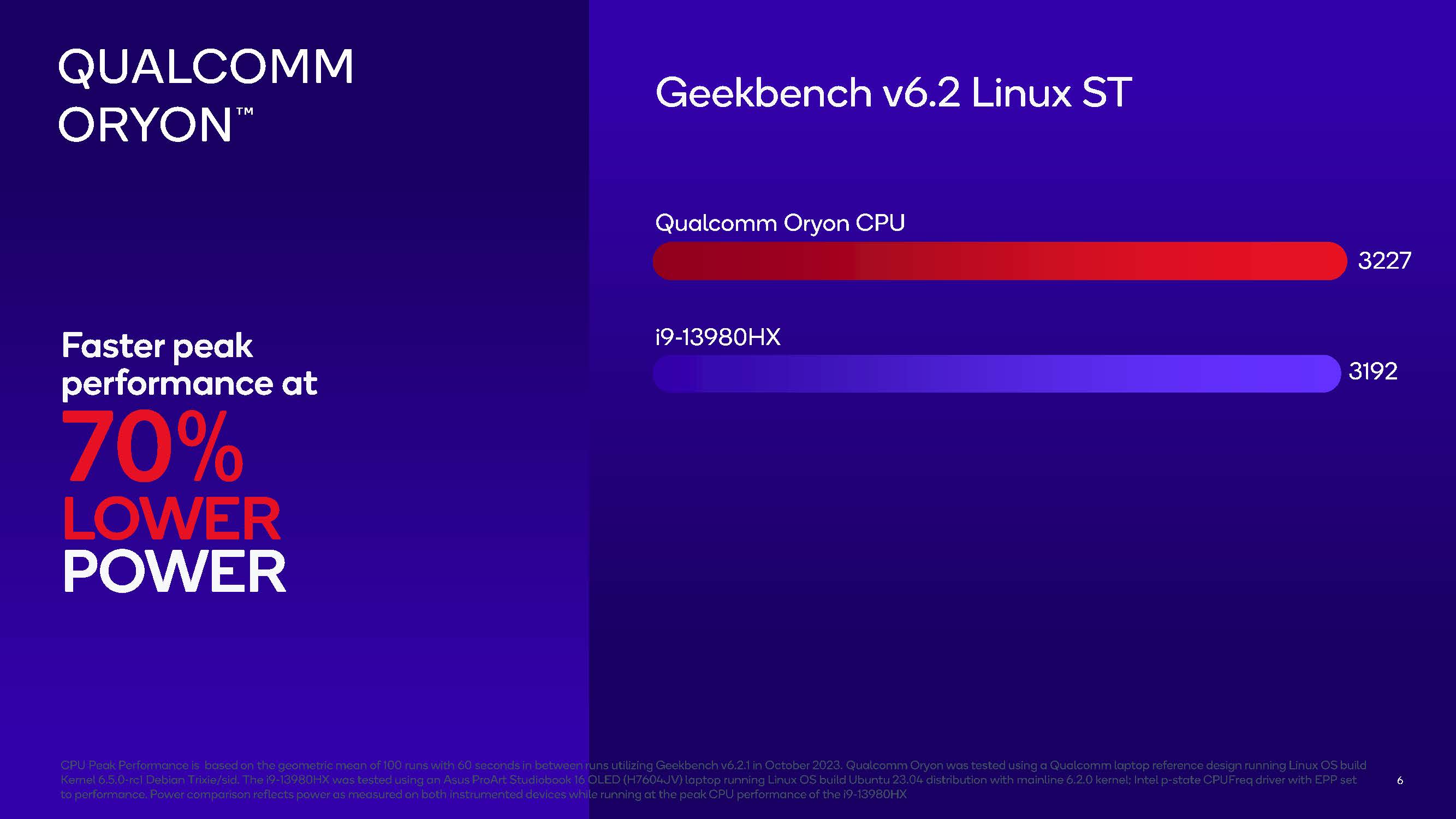
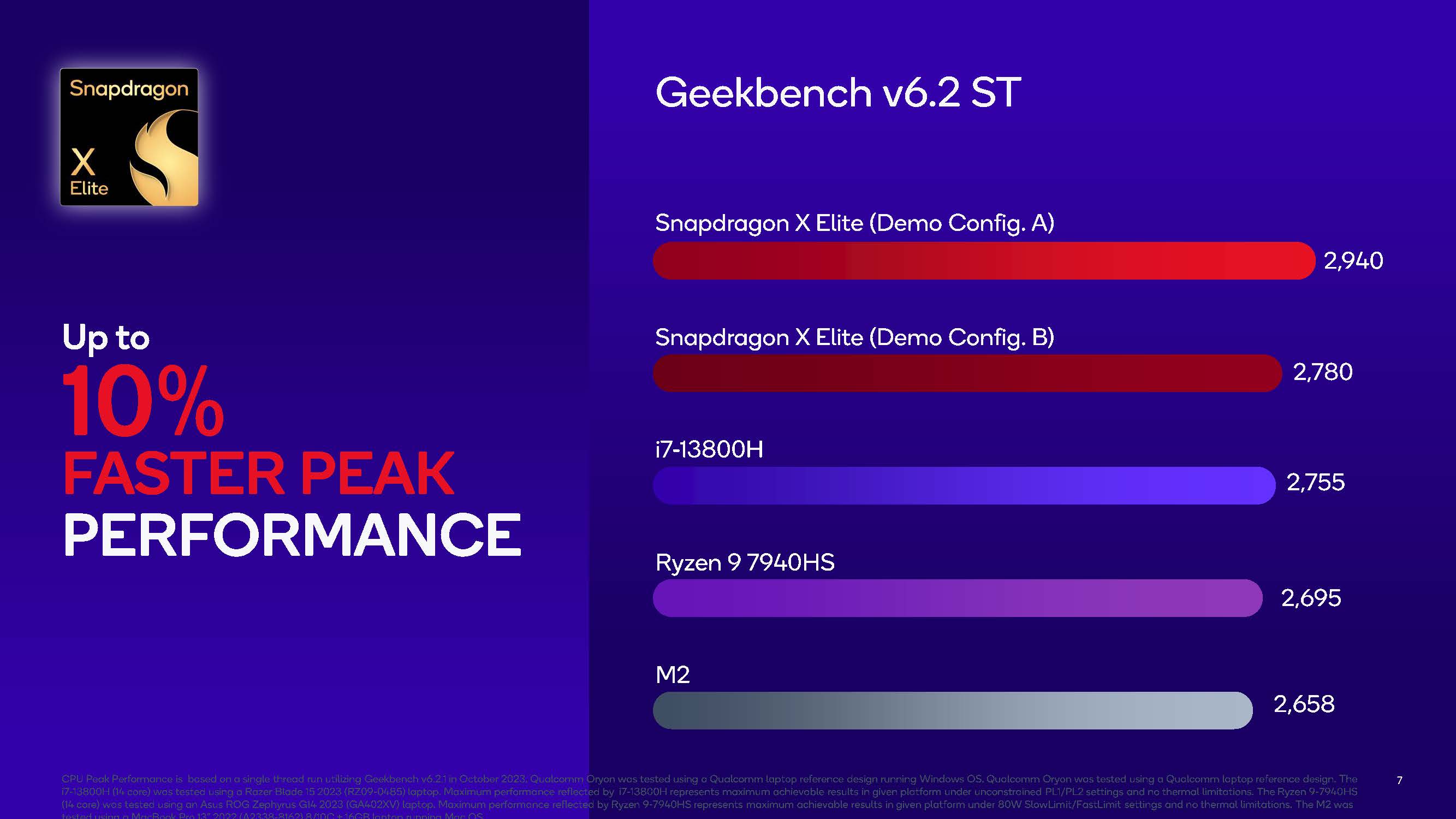
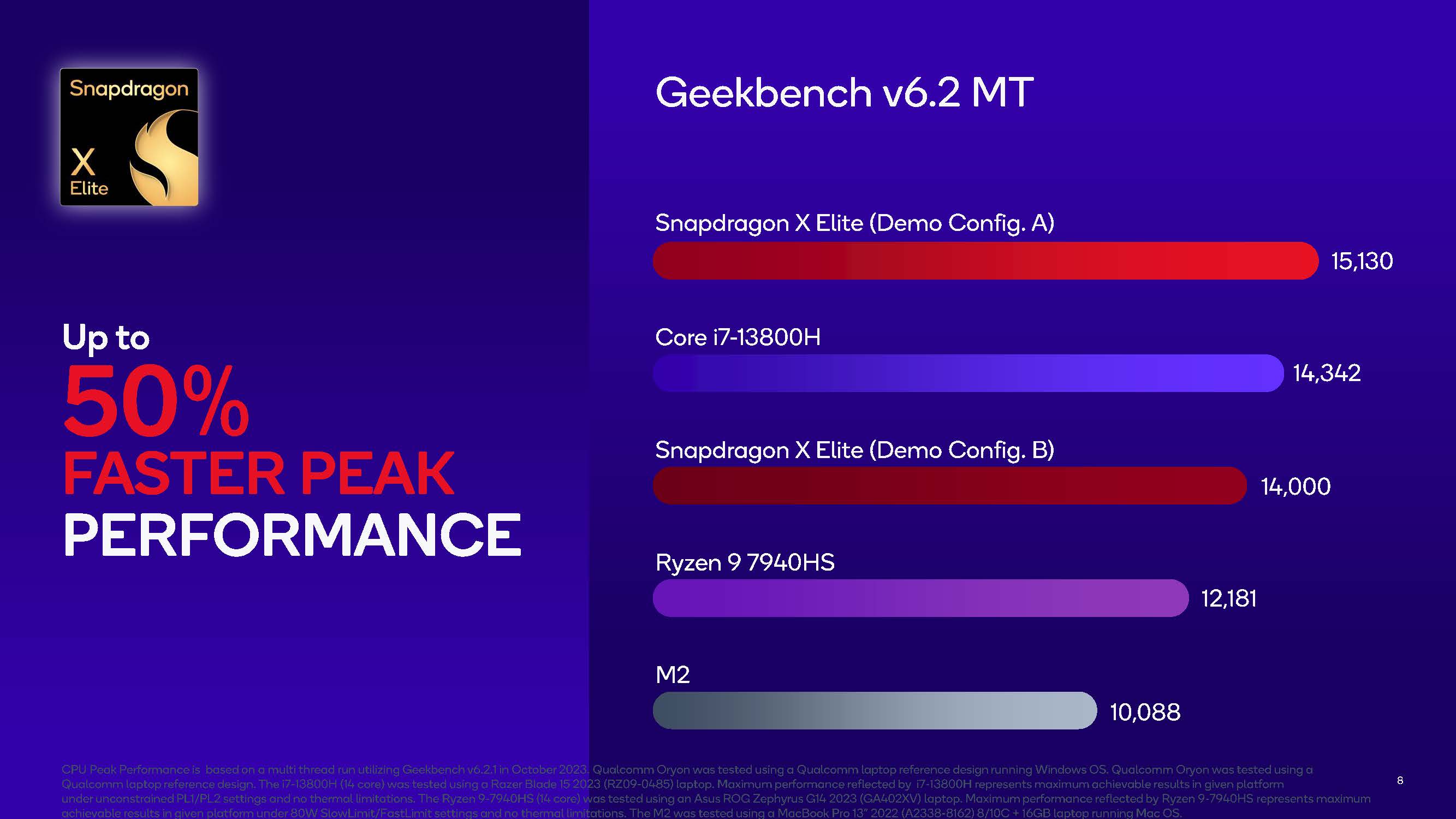
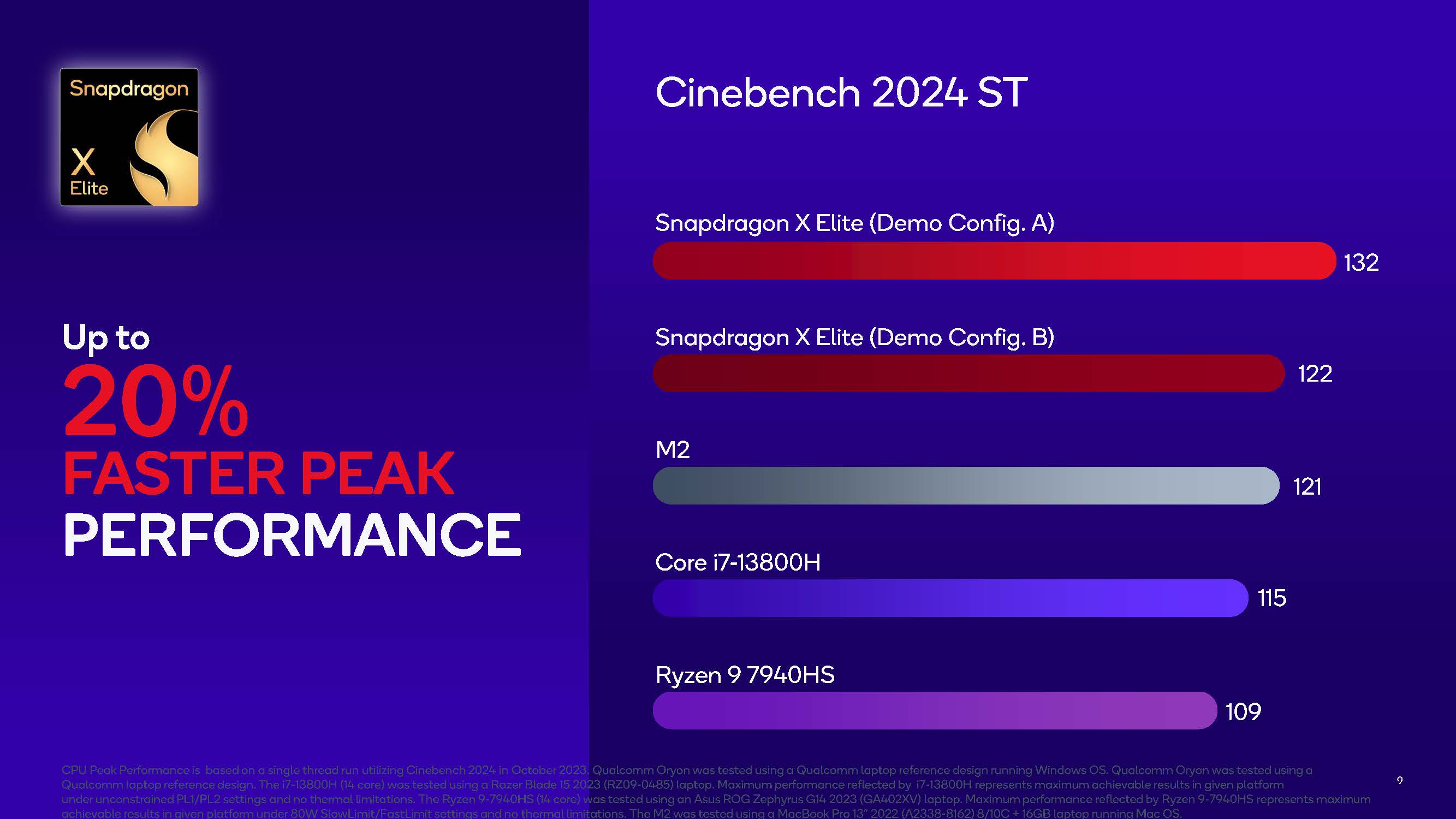
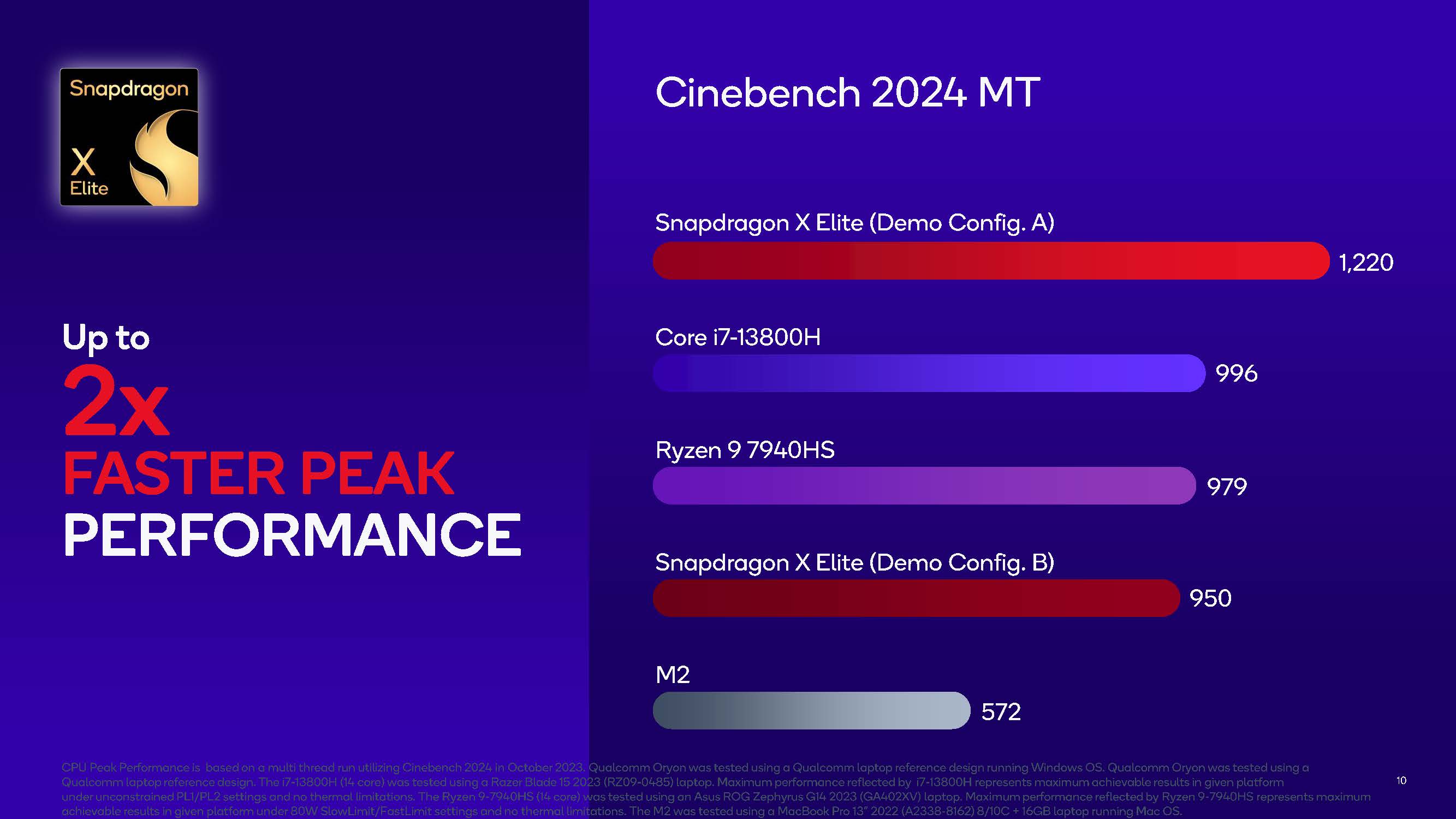
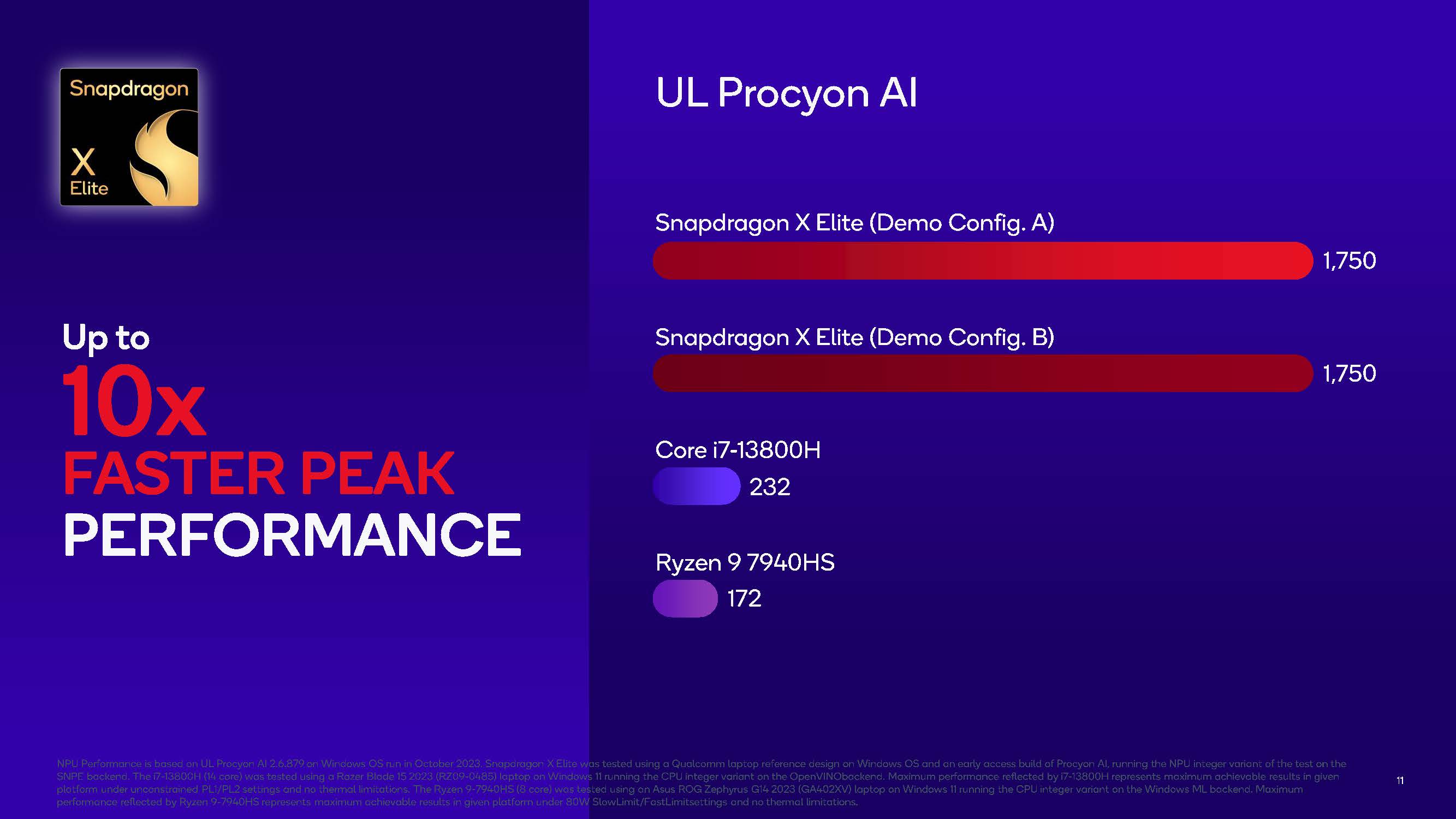
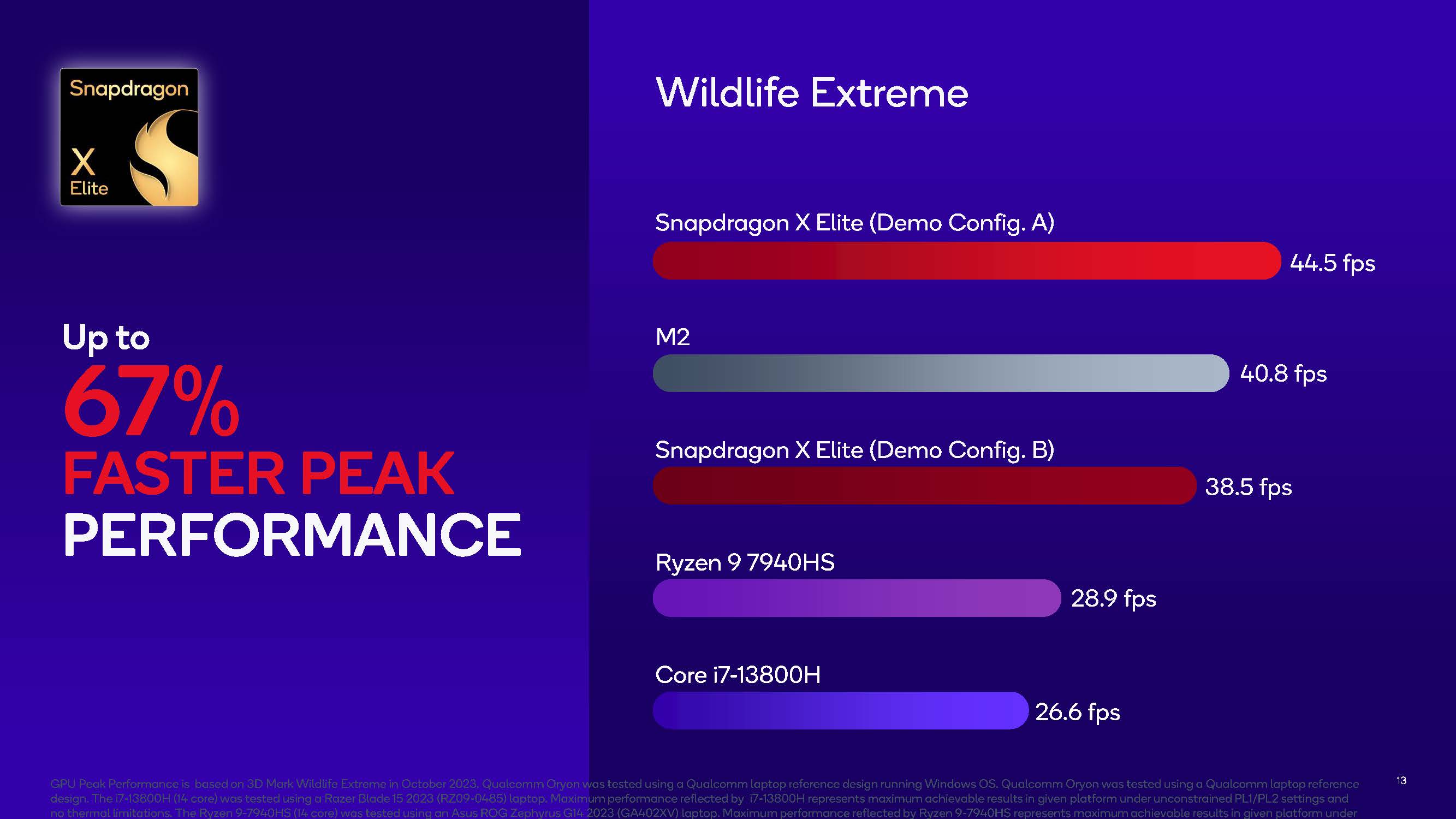

Snapdragon X Elite-equipped laptops won't arrive on the market until mid-2024. That's a long wait, and by the time the Snapdragon X Elite hits retail, it'll likely have to contend with a new generation of Intel, AMD, and Apple chips, such as mobile Raptor Lake Refresh, Strix Point, and the M3.

Zhiye Liu is a news editor, memory reviewer, and SSD tester at Tom’s Hardware. Although he loves everything that’s hardware, he has a soft spot for CPUs, GPUs, and RAM.
-
kaalus Why did they not compare against M2 Pro, which has similar TDP to Snapdragon? The vanilla M2 they tested against has half of the performance cores and half of the GPU cores of M2 Pro, so you can pretty much double Apple scores in all categories in the table. Suddenly, Snapdragon does not look so good.Reply
And M2 is over a year old. In fact, M3 is likely coming out later today during the Apple event. -
bit_user Hey, where are the graphs?Reply
From Anandtech:
Source: https://www.anandtech.com/show/21112/qualcomm-snapdragon-x-elite-performance-preview-a-first-look-at-whats-to-come
The Anandtech article has more, including iGPU performance.
Since the Snapdragon X Elite is made on TSMC N4, the comparison vs. Ryzen 9 7940HS is on the same node. The M2 is at a slight disadvantage, being made on TSMC N5. The M3 will use TSMC N3 (or N3E), which should make that matchup a lot more interesting. -
bit_user Reply
The cynical interpretation would be that they wanted to make themselves look better. However, their decision would be defensible if they're planning on pricing closer to the M2 than M2 Pro (which I doubt - this is Qualcomm, after all).kaalus said:Why did they not compare against M2 Pro, which has similar TDP to Snapdragon? -
suryasans Reply
This article is just a resume from Anandtech's article which is the first hand.bit_user said:Hey, where are the graphs?
From Anandtech:
Source: https://www.anandtech.com/show/21112/qualcomm-snapdragon-x-elite-performance-preview-a-first-look-at-whats-to-come
The Anandtech article has more, including iGPU performance.
Since the Snapdragon X Elite is made on TSMC N4, the comparison vs. Ryzen 9 7940HS is on the same node. The M2 is at a slight disadvantage, being made on TSMC N5. The M3 will use TSMC N3 (or N3E), which should make that matchup a lot more interesting. -
bit_user Reply
Anandtech didn't make the graphs, though. Those are slides from Qualcomm. No reason not to include them here.suryasans said:This article is just a resume from Anandtech's article which is the first hand. -
JamesJones44 Reply
The Config B setup is basically identical to an M2 Max performance wise. 2780 SC (SXE) vs 2736 SC (M2 Max) and 14000 MC (SXE) vs 14493 MC (M2 Max).kaalus said:Why did they not compare against M2 Pro, which has similar TDP to Snapdragon? The vanilla M2 they tested against has half of the performance cores and half of the GPU cores of M2 Pro, so you can pretty much double Apple scores in all categories in the table. Suddenly, Snapdragon does not look so good.
And M2 is over a year old. In fact, M3 is likely coming out later today during the Apple event.
The M2 Max manufactured on the N5P while the Snapdragon X Elite is on the N4. The N4 node is an enhanced 5 NM node so there isn't much difference there. I'm not surprised the numbers basically line up with an M2 Max (I guess I am a little because I don't believe the Snapdragon X Elite has the memory on package, but it does have 2 extra cores) .
Remember Apple has exclusivity rights to the TSMC's 3NM node until the end of the year ish (don't remember the exact date 3NM opens for other customers). -
Alvar "Miles" Udell That's all well and good, but the real question is how (and IF) it will perform with x86, being an ARM chip. Part of Apple's success with the M silicon is it has blanket support and the performance loss for x86 translation is minimal. If Snapdragon X Elite either doesn't work with x86 or has a decent performance hit, then it's not going to matter to anyone who doesn't use programs which have an ARM variant.Reply -
bit_user Reply
TSMC N4 is supposed to have 6% higher density and approximately 4% better performance (at the same power), than N5.JamesJones44 said:The M2 Max manufactured on the N5P while the Snapdragon X Elite is on the N4. The N4 node is an enhanced 5 NM node so there isn't much difference there.
Source: https://fuse.wikichip.org/news/6439/tsmc-extends-its-5nm-family-with-a-new-enhanced-performance-n4p-node/
There's also N4P, which ups the performance advantage to 11%.
I'm not sure if they've said how it's connected, but they did say they're using LPDDR5X-8533, which I'm not sure you can do off-package. That's certainly faster than the LPDDR5-6400 the M2 uses. That's enough to net them 136 GB/s of bandwidth, at only 128-bit. It seems the main benefit of putting it on-package is really power savings, which you can turn around and spend on frequency, if you want the additional performance.JamesJones44 said:I'm not surprised the numbers basically line up with an M2 Max (I guess I am a little because I don't believe the Snapdragon X Elite has the memory on package, but it does have 2 extra cores) .
Unlike desktop PCs, phones have long been able to adjust their memory frequency on-demand. I'm sure their new laptop SoC is doing this with memory, as well. So, even though it might burn a lot of power at 8533 MT/s, it's only running that fast when under heavy load. The rest of the time, they can scale back and enjoy some power savings.
That's irrelevant now, because Qualcomm said devices wouldn't be shipping until mid 2024. However, it probably factored into their decision to use N4, since I'm sure they expected to have it in shipping devices this year.JamesJones44 said:Remember Apple has exclusivity rights to the TSMC's 3NM node until the end of the year ish (don't remember the exact date 3NM opens for other customers).